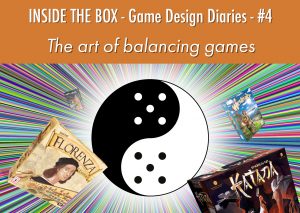 For our segment “Game Design Diaries”, we have been tempted for a while to go into more details about our games’ development process. We believe that balancing Placentia games is an extremely important work, that we love doing and we consider one of the strengths of our publishing house.
For our segment “Game Design Diaries”, we have been tempted for a while to go into more details about our games’ development process. We believe that balancing Placentia games is an extremely important work, that we love doing and we consider one of the strengths of our publishing house.
In the midst of these considerations, this very interesting article was published, explaining how to use Excel for game development which made us think: “let’s do it!”
So:
How do we balance our games?
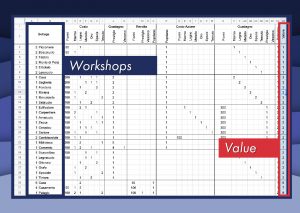
To answer this question, we are going to look at the excel tables that we created to balance workshops and artworks in Florenza X Anniversary.
It all starts finding a normalized value, an X factor, which you can see in the last column. This value is not shown in any way in the game, we only need it to understand the impact that each workshop has on the development of the game.
You can also find this value in the sheet dedicated to artworks in the Piazza. You’ll see that the value of these Artworks is considerably higher: building Duomo decorations is a great idea to ensure victory! 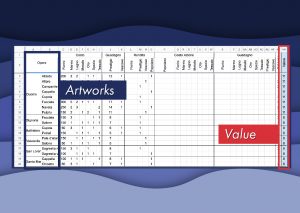 Looking at the formula to find the value, you’ll notice that each prestige point is worth exactly 1 and achieving a specific resource rewards a capped value, depending on the importance of that resource in the game. For instance, marble and wood are the most precious materials because they are needed to build many buildings, so their value is higher.
Looking at the formula to find the value, you’ll notice that each prestige point is worth exactly 1 and achieving a specific resource rewards a capped value, depending on the importance of that resource in the game. For instance, marble and wood are the most precious materials because they are needed to build many buildings, so their value is higher.
The idea is easy, it is true that to win you need to build Artworks that assign Prestige Points, but artworks are expensive! Owning a shop that automatically generates resources offers a great foundation to snatch victory. And all this must be somehow quantified.
But how do you calculate the value of every single resource?
First, Matteo drafts up table and, based on some initial data, creates the first stress tests, which is a test aimed at finding if there are dominating strategies. As soon as he manages to create a “flat” and balanced structure we start the real playtests. Tons of playtests! We need the first few playtests to empirically verify if the values assigned to the resources correspond to reality or if they should be limited, or even exaggerated, to create an imbalance.
What? Are our Eurogames imbalanced? The horror!
The end of the first development stage is when the game works flawlessly, without any imbalance, but if you happened to try one of our games at this point you would find it particularly monotone because all the moves would be equally effective, with the risk of the game “playing by itself”. Our game developer experience taught us that you need resources with better actions than others, as long as under equal conditions all the players can benefit from them. This is because it is important to give gamers some sort of directions in order to start a convincing game strategy. If that wasn’t the case, any choice would sort the same effect as the others, and it wouldn’t make any difference.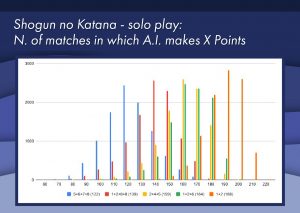
By adding some small aleatory elements we reach conditions that push players to think turn by turn, adjusting each time their plans to reach the planned objective, giving the game a decided edge. All in all, a bit of imbalance is good for your Eurogame.
Aren’t there too many elements to consider in such a complex game like Florenza?
Yes, the only way of looking at every possible strategy in detail is to create a software that simulates thousands of gameplays of your game.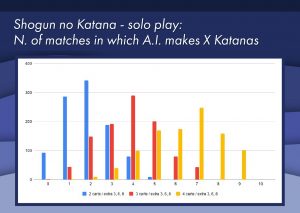 Luckily Matteo is a software programmer, and we could benefit many times from his skills in order to make more complex considerations. No, we have never created a software for a whole game, but we happened to test some specific moments of a game. For instance, we have actually tested all the possible game conditions of Shogun no Katana solo-play, to determine in which conditions the virtual player would more easily win.
Luckily Matteo is a software programmer, and we could benefit many times from his skills in order to make more complex considerations. No, we have never created a software for a whole game, but we happened to test some specific moments of a game. For instance, we have actually tested all the possible game conditions of Shogun no Katana solo-play, to determine in which conditions the virtual player would more easily win.
Without developing a software, other IT tools can help us solving problems: we are talking about model testing and integration testing.
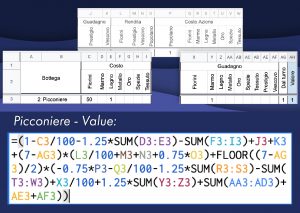 That’s where it gets difficult, doesn’t it? What are they?
That’s where it gets difficult, doesn’t it? What are they?
Model testing means testing each element of the game, such as an action or a specific phase: you extrapolate it from the overall context, and you carry out some specific tests, and then you evaluate the results. For example: in Florenza X Anniversary, in order to evaluate the importance of the workshops that make it possible to perform more than one action for each turn, we carried out some specific tests to understand the value of each earned action. To do this, we could play without Artworks, Captains, the Bishop, so on and so forth…
Integration testing means verifying that all the game parts that have already been tested are well integrated. Thanks to model testing output data, we can carry out targeted tests, skipping some actions all together so that we can evaluate the overall game.
It is complex! Is it worth it?
Of course these tests are not enough to understand if it is a good game, but it is an important starting point, and might suggest interesting ideas. We give you another piece of advice to make your next Eurogame as bubbly as a glass of champagne: make it impossible for players to achieve everything they had planned.
In this way, at the end of the game, they will be pushed to try new strategies, in addition to the fact that a limited number of actions helps solving possible problems of balance and dominating strategy.
For instance, in Florenza you won’t manage to complete your workshops quickly and to earn good income from the artworks placed on the board at the same time, because the results of either paths are maximised if carried out from the beginning, ignoring the other one. You can choose to invest on one of the two, or to find a good balance by partially developing both… Not to mention the fact that at the same time you can choose to try to be the Bishop or not, or to focus on the production buildings or those that offer many workers. All this depends on your skills!
Developing a game doesn’t exclusively consist in calculations: experience, creativity and awareness are equally important. If you think about it, it’s the same for all the creative products.
Are you curious to learn more about Game Design and much more from the Post Scriptum world? Follow us on our Telegram Channel!
